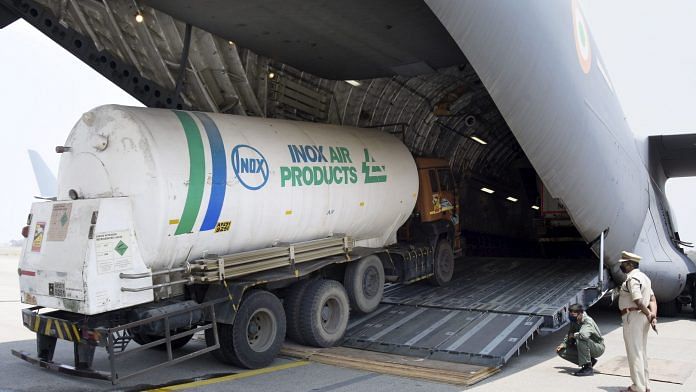New Delhi: An elaborate digital system developed by the Narendra Modi government to track the movement of liquid medical oxygen at the peak of the pandemic’s second wave will be expanded further to prepare for a possible third wave, ThePrint has learnt.
The digital system, which came into being when patients were gasping for breath due to shortage of medical oxygen, was established by an empowered group on Covid management led by Giridhar Aramane, secretary, Ministry of Roads, Transport and Highways. It oversaw requirements related to medical oxygen across the country.
The online system, which constitutes an app and a web-based platform, was launched on 1 May, and in less than three weeks, it monitored over 12,800 trips for more than 1,800 tankers.
While, at present, the demand for oxygen has receded, reports indicate that a possible third wave of the virus will be just as severe as the second one.
Therefore, to avoid the crisis that was seen during early May, the empowered group has decided to expand the digital app and web-based platform.
The main aim of this system, sources in the ministry explained, is to conduct real-time tracking of oxygen tankers while they are in transit, from plants to states and then on to districts.
They further noted that authorities were able to instantly communicate urgent orders and dispatches from oxygen plants through this system.
“Through this system, we can also instantly divert the supply of LMO (liquid medical oxygen) if it reaches one place which has enough oxygen,” a ministry source, who wished to be unnamed, told ThePrint.
Also read: Mukesh Ambani’s RIL is working to produce new Covid drug, cheaper testing kits
How the current system works
The oxygen tracking system is based in all states and 74 production plants across the country. Through this app and web-based system, the central government gets information on delays, unintended stops, route deviations and trip initiations undertaken by tankers carrying liquid medical oxygen (LMO) and cylinders.
The digital platform monitors tankers through GPS systems installed in the vehicles and sim cards of drivers. They also track their movement on trains, when tankers are shuttled using RORO (roll on/roll off) trains.
The data is updated with real-time information of delivery, dispatch and allocation of both LMO tankers and in some places oxygen cylinders as well.
Through the GPS-based system in vehicles carrying the LMO tankers, one is aware of the speed at which the vehicle is moving, route and estimated time of arrival. This tracking system is enabled for state nodal officers, transport commissioners, PESO (Petroleum and Explosives Safety Organization) controllers, health secretaries and others.
A senior ministry official, who is also part of the empowered group, explained that the platform has afforded real-time information on LMO supply and communication across different states.
“If allocation changes then we can communicate this to the oxygen plants immediately,” the official told ThePrint.
He added that the tracker has also given the officials proper information on the oxygen tankers that were getting converted from nitrogen and argon.
“We were able to immediately keep a track of which ones were converted and where they were moving. As well as being able to track the rail movement through ROROs,” he said.
According to sources in the road ministry, the tracking platform also computed a lot of analytics on route optimisation, making it easier for officials to decide on routes that will allow the smoothest supply and delivery of oxygen tankers.
Once the tanker reaches the state, nodal officers put in the details on the dashboard for the government to track.
Also read: How medical oxygen is supplied to hospitals, and why India is facing an acute shortage
Integration with hospital, better tracking systems
According to a State Bank of India (SBI) research document, a third wave of the Covid-19 pandemic in India could potentially be just as bad as the second. Consequently, the country could once again witness a surge in the demand for medical oxygen.
Therefore, to ensure there is no shortage and to further develop the tracking system, officials in the empowered group will improve it, to directly connect to hospitals and other health facilities. This will help gauge the demand for oxygen.
“We plan on integrating hospital and healthcare facilities as well, so that we get a more accurate and comprehensive aggregate demand function,” the officials said.
Besides this, two other measures have been proposed to states. First is an RFID (radio-frequency identification) tracking system for cylinders that will keep track of movement and use of oxygen cylinders across locations. It will also give real-time updates and details of oxygen cylinder filling and maintenance history.
The other measure is tracking and monitoring cylinders through QR codes. Once you scan the QR code on the cylinder, then there is no need to even upload details, it gets filled onto the dashboard automatically.
However, the main focus in preparation for the third wave is to reduce the time for supplying oxygen to those who critically require it. “We currently are at an average of six hours, this has to be brought down to two,” said a source in the road ministry.
Also read: How many doses of Covid vaccines will India get from US? We’ll know in a matter of days



